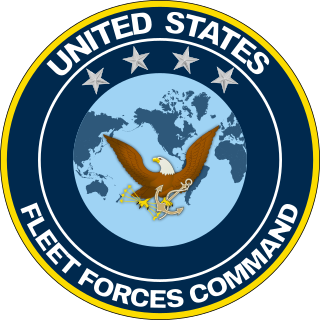
The United States Fleet Forces Command (USFF) is a service component command of the United States Navy that provides naval forces to a wide variety of U.S. forces. The naval resources may be allocated to Combatant Commanders such as United States Northern Command (USNORTHCOM) under the authority of the Secretary of Defense. Originally formed as United States Atlantic Fleet (USLANTFLT) in 1906, it has been an integral part of the defense of the United States of America since the early 20th century. In 2002, the Fleet comprised over 118,000 Navy and Marine Corps personnel serving on 186 ships and in 1,300 aircraft, with an area of responsibility ranging over most of the Atlantic Ocean from the North Pole to the South Pole, the Caribbean Sea, Gulf of Mexico, and the waters of the Pacific Ocean along the coasts of Central and South America.

Frank Friday Fletcher was a United States Navy admiral who served in the late 19th and early 20th centuries. He was awarded the U.S. military's highest decoration, the Medal of Honor, for his actions as commander of navy forces at the Battle of Veracruz, Mexico. The Fletcher-class destroyer, the most produced class of United States Navy destroyers, was named after him. He was also the uncle of Frank Jack Fletcher, another U.S. Navy Admiral who also received the Medal of Honor for actions at Veracruz, and who commanded U.S. naval forces at the battles of Coral Sea and Midway during the Second World War.

Robley Dunglison Evans, born in Floyd County, Virginia, was a rear admiral in the United States Navy, who served from the American Civil War to the Spanish–American War. In 1907–1908, he commanded the Great White Fleet on its worldwide cruise from the Atlantic Ocean through the Straits of Magellan to the Pacific Ocean.

Vice Admiral William Satterlee Pye was a U.S. Navy officer who served during World War I and World War II, but never saw combat action. His last active-duty appointment was as President of the Naval War College, in 1942–1946. His awards included the Navy Cross for his distinguished service as a staff officer during World War I.
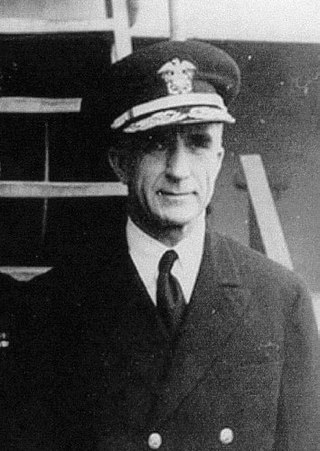
Vice Admiral Morton Lyndholm Deyo was an officer in the United States Navy, who was a naval gunfire support task force commander of World War II.

United States Naval Forces Europe and Africa (NAVEUR-NAVAF), is the United States Navy component command of the United States European Command and United States Africa Command. Prior to 2020, NAVEUR-NAVAF was previously referred to as United States Naval Forces Europe – Naval Forces Africa and sometimes referred to as United States Naval Forces Europe – Africa.

Kurt Walter Tidd is a retired United States Navy admiral. He last served as the Commander, United States Southern Command. Prior to that assignment, Tidd served as Assistant to the Chairman of the Joint Chiefs of Staff. He also served as the Director for Operations, Joint Staff (J-3) from 2012 to 2013, and as Commander, United States Naval Forces Southern Command and United States Fourth Fleet from August 5, 2011, to June 22, 2012. Confirmed by the Senate on December 16, 2015, Tidd received his fourth star and succeeded John F. Kelly as commander of United States Southern Command on January 14, 2016. Tidd held the title of "Old salt", which means he received his qualification for Surface Warfare before any other active-duty navy officer. He passed said title to Admiral Philip S. Davidson upon his retirement. Upon the May 30, 2018, retirement of his United States Naval Academy classmate, Admiral Harry B. Harris Jr., Tidd also gained the honorific of "Old Goat" – the longest-serving Naval Academy graduate on active duty. Harris presented Tidd with the Old Goat decanter in a ceremony on April 11, 2018.

Harry Wilbur Hill was an admiral in the United States Navy during World War II.

Mark Howard Buzby is a retired United States Navy rear admiral who served as the Administrator of the United States Maritime Administration. He retired from the Navy in 2013 and joined Carnival Cruise Line's Safety & Reliability Review Board. Buzby was nominated to be MARAD Administrator in June 2017 by President Donald Trump, and confirmed to the position by the United States Senate on August 3, 2017. He resigned from the post on January 11, 2021, along with Secretary of Transportation Elaine Chao, to protest the 2021 United States Capitol attack.

Harold Webster Gehman Jr. is a retired United States Navy four-star admiral who served as NATO's Supreme Allied Commander, Atlantic (SACLANT), Commander-in-Chief of the United States Joint Forces Command, one of the United States' Unified Combatant Commands, and Vice Chief of Naval Operations. He was also the Co-Chairman of the Commission that investigated the terrorist attack on the USS Cole and was Chairman of the Columbia Accident Investigation Board (CAIB) after the Space Shuttle Columbia disintegrated during reentry in 2003, killing all seven crew members.

William Evans "Bill" Gortney is a retired United States Navy admiral who served as the sixth commander of United States Northern Command and the 23rd commander of North American Aerospace Defense Command (NORAD). He previously served as the Commander, United States Fleet Forces Command from September 14, 2012 to December 2014 and Director of the Joint Staff from July 1, 2010 to August 2012. Prior to that, he served as Commander, U.S. Naval Forces Central Command/5th Fleet. He assumed his post as CDRUSNORTHCOM and commander of NORAD on December 5, 2014, and was succeeded by General Lori Robinson on May 13, 2016.

Herbert Fairfax Leary was a highly decorated officer in the United States Navy with the rank of vice admiral. A son of Rear Admiral Richard P. Leary, he distinguished himself during World War I while on the staff of Commander, U.S. Naval Forces in Europe under Admiral William Sims and received the Navy Cross, the United States Navy's second-highest decoration awarded for valor in combat.
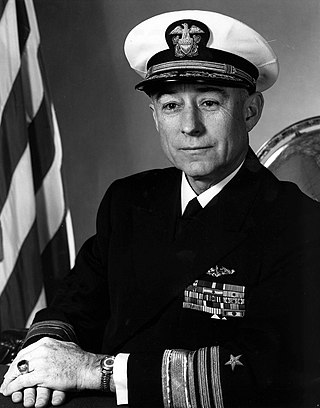
Bernard Lige Austin was a Vice Admiral of the United States Navy. His career included service in World War II, the Korean War, and the Cold War and command of submarines and surface ship forces, during which he became a distinguished combat commander of destroyers. He also commanded the United States Second Fleet, held numerous diplomatic, educational, and administrative staff positions, and a served a lengthy tour of duty as President of the Naval War College.

Harold Cecil Train was a rear admiral in the United States Navy who served as the Director of the Office of Naval Intelligence between 1942 and 1943 and as commanding officer of the battleship USS Arizona. He was father of Admiral Harry D. Train II and grandfather of Rear Admiral Elizabeth L. Train.
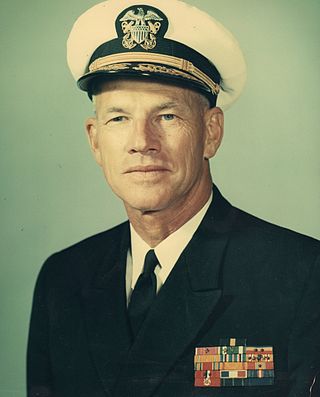
Lloyd Montague Mustin was a vice admiral in the United States Navy and among the namesakes of USS Mustin (DDG-89). He took part in developing the Navy's first lead-computing anti-aircraft gun sight, which proved of major importance in the air-sea actions of World War II, and he served on the cruiser USS Atlanta during the naval battle of Guadalcanal. His ship was lost during that action, and with other survivors he landed on Guadalcanal and served ashore with a naval unit attached to the First Marine Division. His postwar service included commands at sea and development and evaluation of weapon systems. He later served as director of operations for the Joint Chiefs of Staff during the Vietnam War.
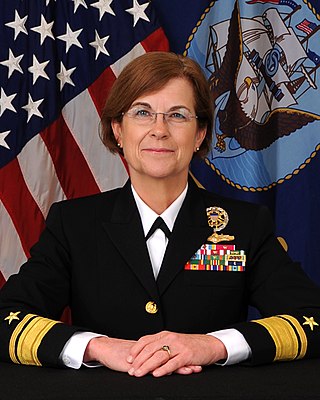
Elizabeth Langdon Train is a retired United States Navy rear admiral who was the Commander, Office of Naval Intelligence and the Director, National Maritime Intelligence-Integration Office. Train is a third generation naval officer, her father is Admiral Harry D. Train II and her grandfather is Rear Admiral Harold C. Train.

Francis Stuart Low CBE was a decorated officer of the United States Navy with the rank of four-star Admiral. An expert in submarine warfare, Low is credited with the idea that twin-engined Army bombers could be launched from an aircraft carrier. This idea was later adopted for the planning of the Doolittle Raid.
Charles Johnes ‘Carl' Moore was a Rear Admiral of the United States Navy. He was the chief of staff of Raymond A. Spruance, commander of the Fifth Fleet, during the most important and significant naval campaigns of the World War II in the Pacific Theater: the Gilberts, the Marshalls and the Marianas.
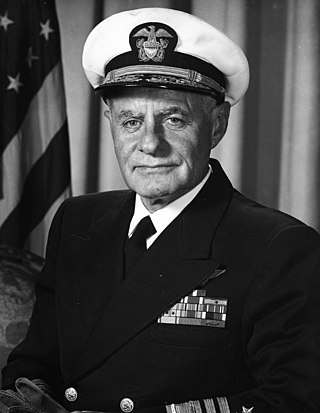
Wallace Morris Beakley was an American naval aviator, diplomat, commander of the United States Seventh Fleet, deputy chief of naval operations, and vice admiral in the United States Navy. He served as vice chief of naval operations for Atlantic Fleet and commander in chief for Western Atlantic until he retired from the U.S. uniformed services in 1964.
John Dandridge Henley Kane, Jr. was a rear admiral in the United States Navy. He was born at Newport, Rhode Island about 1921 and died on August 6, 2013 in Bethesda, Maryland. He served as the Director of Naval History for nine years from August 1976 until December 1985, where he "established, strengthened, and inspired many aspects of the Navy's history program."



















